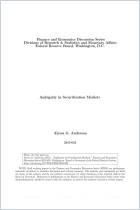Acesse a sua conta getAbstract para obter o resumo!

Acesse a sua conta getAbstract para obter o resumo!
The Wall Street Journal
The Repo Market, Explained
The Wall Street Journal, 2019
Sobre o que é?
Why was the market in a panic over repos in September 2019? Find out what went wrong in this smart video.
Recommendation
For market stakeholders, September 2019 brought back some bad memories of the 2008 credit crisis, as financial liquidity froze and short-term borrowing costs skyrocketed. For the public, the repurchase agreement (repo) is not a household name, but it is critical to the health and vibrancy of the US financial system. This easy-to-follow video from The Wall Street Journal explains how the repo market ticks, why it triggered panic and what deeper regulatory issues might threaten its efficient functioning. New investors and finance students will find this a basic but valuable primer.
Summary
About the Speaker
WSJ Video is a part of the Wall Street Journal Digital Network.




















Comment on this summary